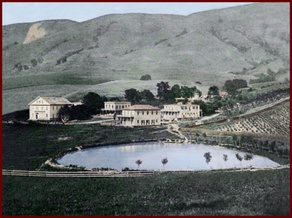Long before the arrival (1776-1769, then back in 1795) of the Spaniards, the Ohlone Indians used to live near the Warm Springs area for the medicinal benefit of its mineral water. In 1839, more than 9,000 acres of the land surroundings the springs was granted to Fulgencio Higuera by Juan Alvarado, the Mexican Governor. The name of his grant was Rancho del Agua Caliente, the Spanish version of the name that has persisted to this day. Spanish families living in nearby areas sent ox carts laden with clothing to be washed by laborers in the hot soft water. Woolen goods washed in the spring water required very little soap and, after washing, were as soft and white as when new. In 1850, an entrepreneur named Clemente Columbet bought the property from Fulgencio Higuera and established a vineyard and built his famous Warm Springs Hotel and spa here, which eventually became a fashionable resort site for wealthy San Franciscans. The hotel was damaged in the great earthquake of 1868.
The three-story, white-with-red-trim hotel -- the only surviving building from a 19th-century spa -- was part of the first hot springs resort on the West Coast. When it opened in the early 1850s, it catered to the elite of the new state of California. When Clement Columbet opened the spa, there were 10 buildings on both sides of Agua Caliente Creek. Springs fed warm soda-, borax- and sulfur-enhanced water into the basement of six buildings. In its heyday, the spa attracted the likes of Pio Pico, the last Mexican governor of California; Sen. George Hearst of the newspaper empire; Domingo Ghiradelli of the chocolate family; and Adolph Sutro, mayor of San Francisco and owner of a competing bath at the Cliff House., also judges, lawyers, business men and even some local residents. They came from near and far to frolic, hold meetings, rest or relieve pain in the medicinal waters. Hundreds of people flocked to the resort to bathe in the healing waters, relax, dine, gamble and seek recreation and entertainment. The waters came to be regarded as a cure for all internal and external ills.
In 1870 Leland Stanford, the powerful railroad magnate and Governor of California, bought the repaired hotel. His brother Josiah lived there and improved the vineyards and the winery and also raised horses. Subsequently, the original grounds of the hotel served as a private park. Its swimming pool was heated by the hot springs, which were still producing 60,000 gallons of water a day, with an average temperature of 95 degrees, as late as 1920. The one remaining hotel building from the 1853 served as a road house until its upper floor was condemned after it was damaged in the 1906 earthquake. Mrs. Stanford prefer the peninsula to the east bay. They moved back to that side of the bay and as we all know Stanford University was built. Just think Stanford University could have been right here in Fremont if Leland has his way. We know who wore the pants in that family. The site of the Hotel is California Historical Landmark No. 642. 1.
The next thirty years saw various owners and commercial uses, including a period when it was a horse-racing track!
When the Weibel Family arrived in 1946 all that was left of the Leland Stanford Winery was a dilapidated brick building leaning against the hills that overlooked the gnarly grapevine stumps. They left years later yet still produce wine in Lodi. http://www.weibel.com/
The last major building there was the A.A. Cohen Hotel, which burned down in 1992. 2.
As a young girl, in the 60's and 70's; I remember fondly of church & school picnics at the old Warm Springs Hotel, that was now called Hidden Valley Ranch. I remember the water smelling and tasting funny yet I had no idea what I was swimming in. Now that I am older and have gone thru many diseases I am devastated that we no longer have these healing waters locally. I remember as a young adult going dancing up at Hidden Valley, it was many things. Now in place of these wonderful waters are a housing development.
Warm Springs Hotel circa 1869 Post card from the Stanford's.
Citations :
1. Oral History Associates (Sausalito, Calif.) City of Fremont: The First Thirty Years : History of Growth. Fremont, Calif.?: Mission Peak Heritage Foundation, 1989. Print.
Photo's courtesy of www.tricityvoice.com




